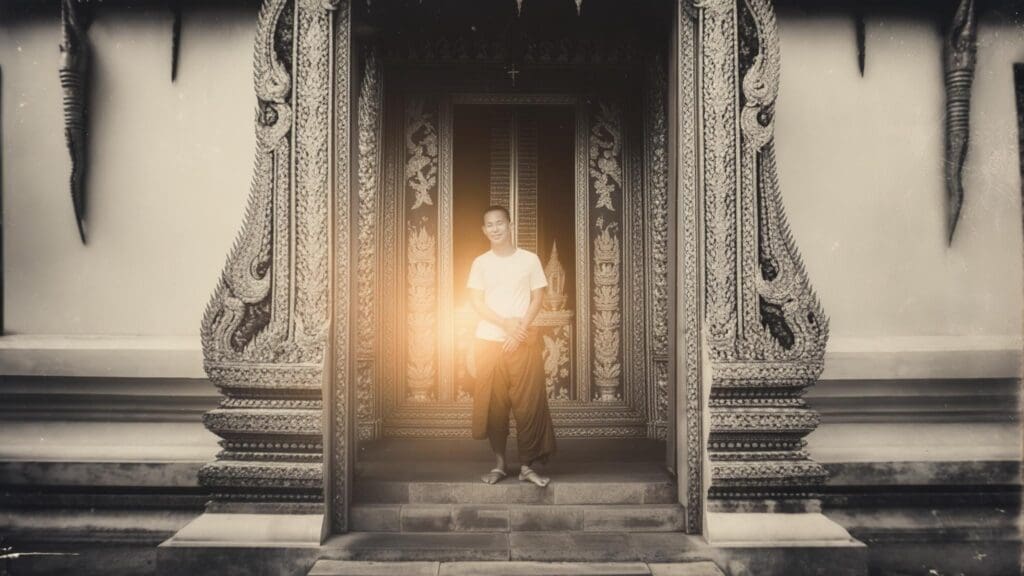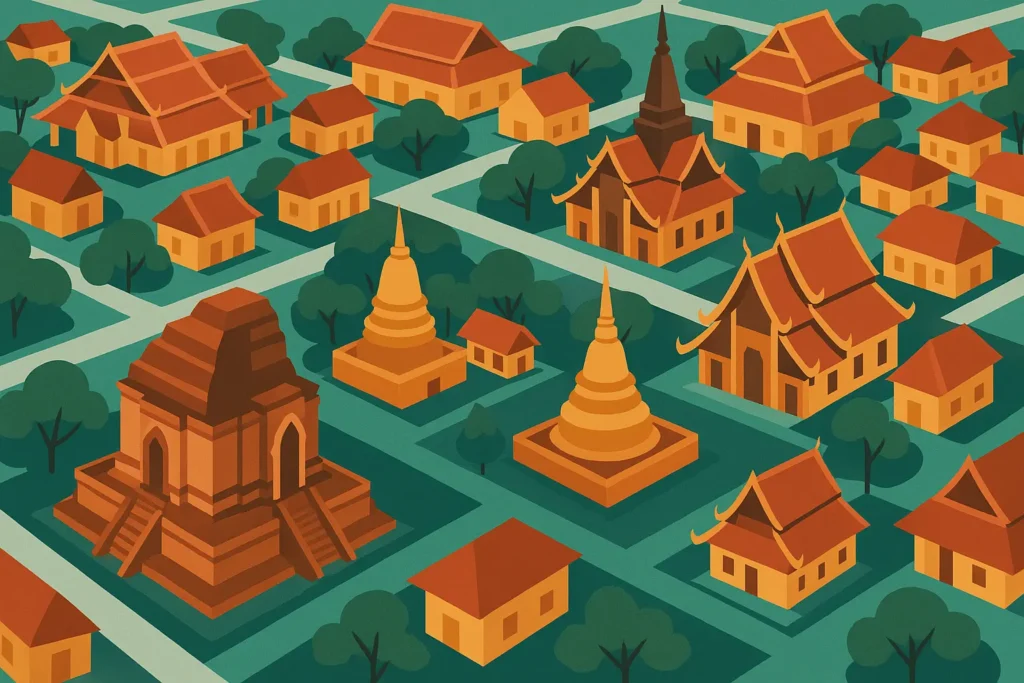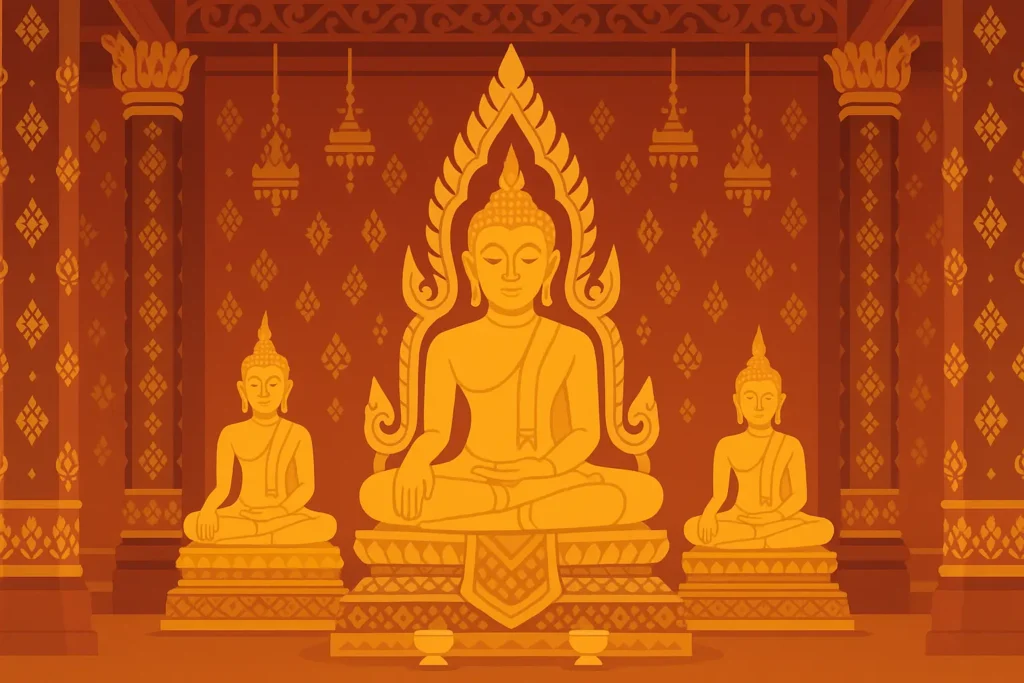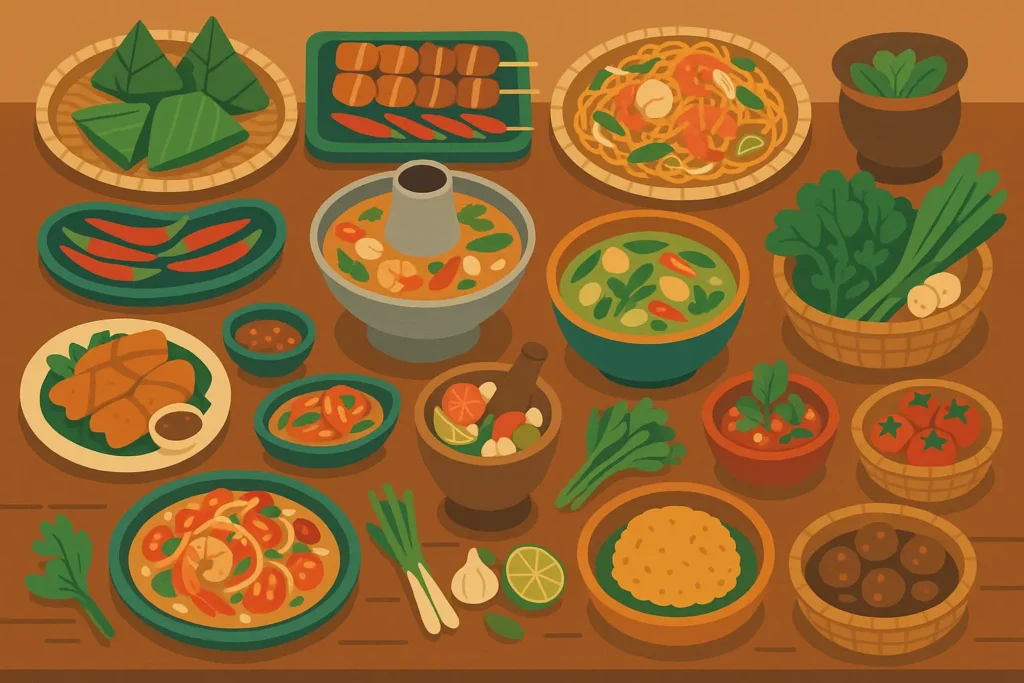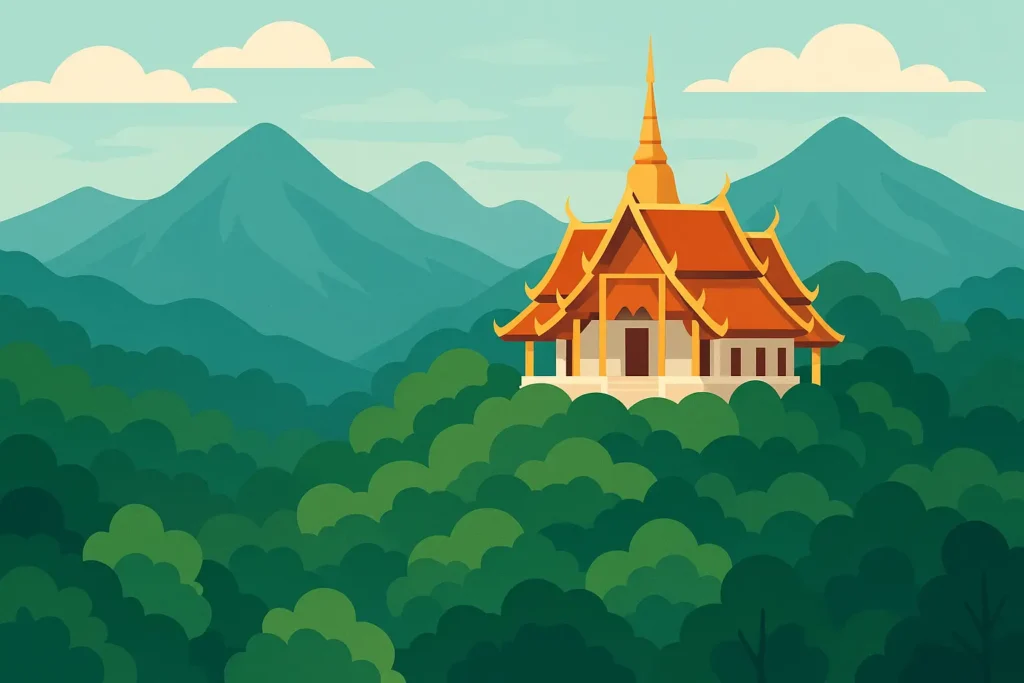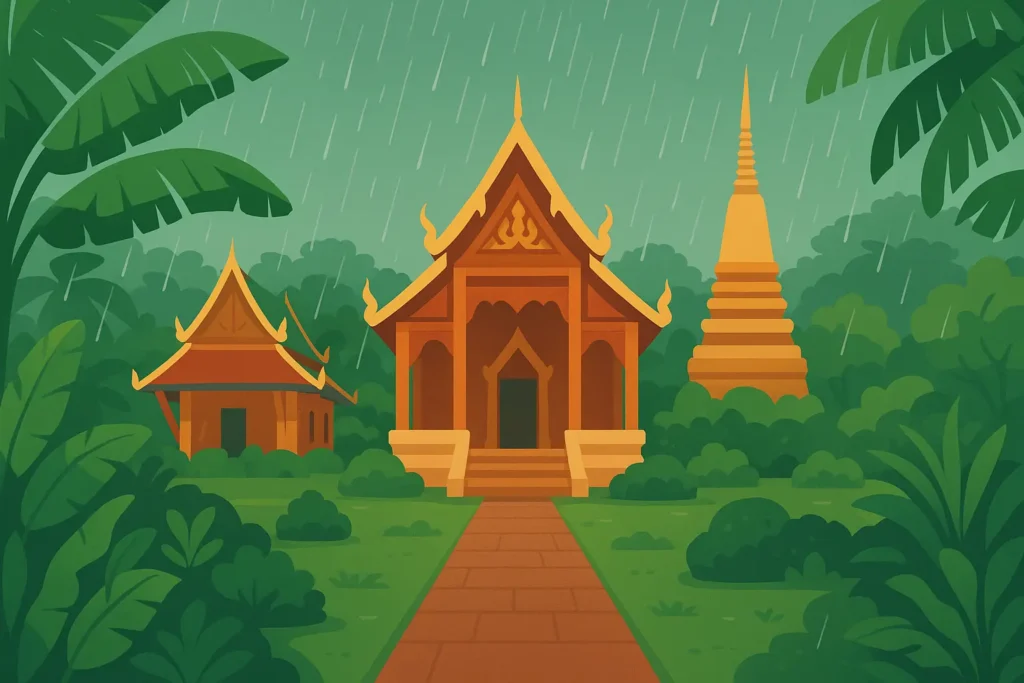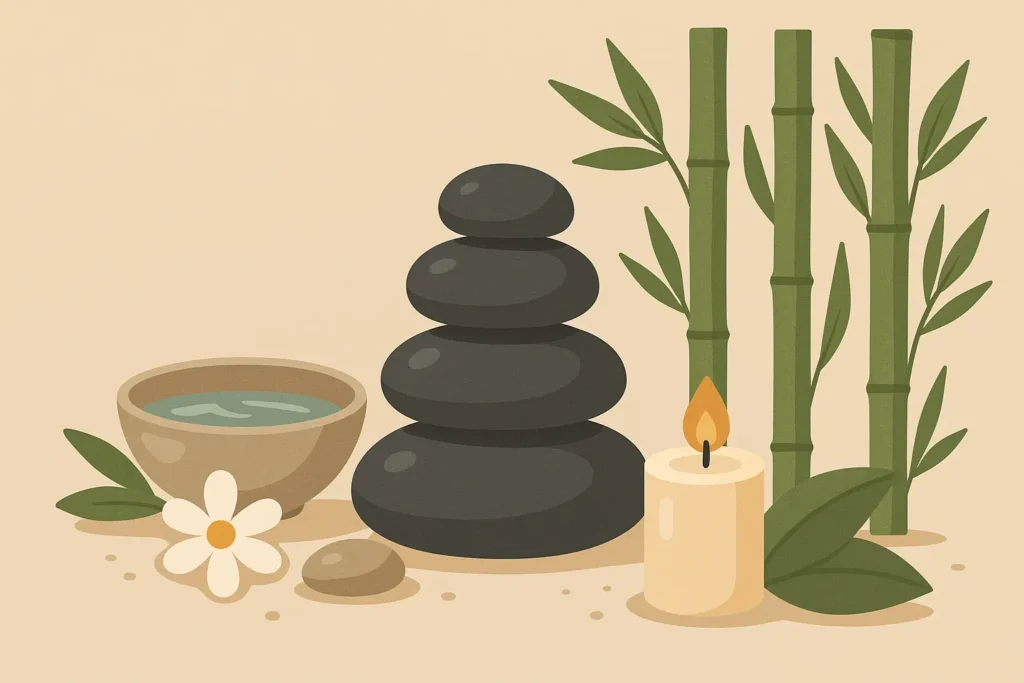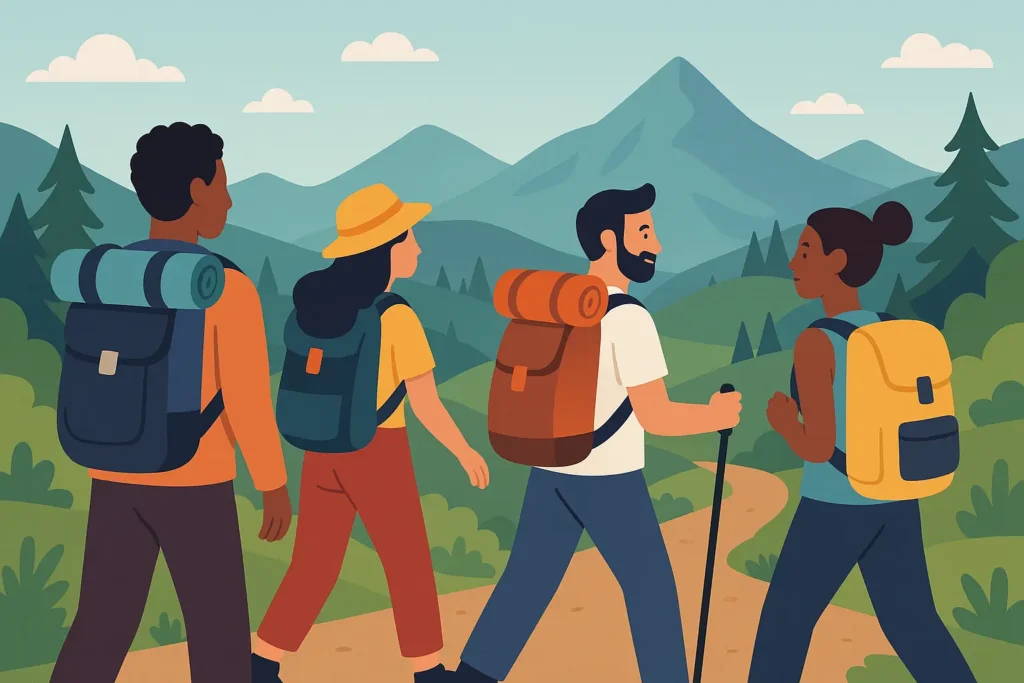Planning a trip to Northern Thailand can feel overwhelming when you’re staring at endless temple options and wondering if you’ll survive the heat. According to recent travel data, most first-time visitors spend only 3 days in Chiang Mai, barely scratching the surface of what this place offers. I remember my first visit – standing in the middle of the Old City square, guidebook in hand, completely paralyzed by choice. Should I prioritize ancient temples, venture into the mountains, or just eat my way through the legendary food scene?
That overwhelming feeling is exactly why I put together this collection of Chiang Mai itineraries. After making plenty of mistakes here (and learning from them), I’ve figured out what actually works for different types of travelers.
Quick Resources:
Create your personalized Chiang Mai Thailand itinerary with our Vacation Planner
Stretch your travel budget smarter with the free Bachelorette Budget Calculator
Find your travel vibe with the free AI Color Analysis Quiz
Explore the full suite of tools to plan your perfect journey: All Wedding Tools
Whether you’re a budget backpacker trying to stretch $30/day or someone who wants luxury experiences, there’s something here that’ll work for you. These aren’t perfect templates – they’re real plans based on what I’ve seen work (and fail spectacularly) for actual travelers.
Create your custom Chiang Mai Thailand itinerary with our Vacation Planner
Just like planning any big trip requires thinking about timing and who you’re traveling with, planning life’s major celebrations needs the same careful approach to create unforgettable experiences.
TL;DR
- 25 Chiang Mai itineraries that cover every budget ($30-$150+/day) and travel style
- Duration options from quick 3 days in Chiang Mai highlights to week-long adventures
- Specific plans for foodies, temple hoppers, adventure seekers, and culture lovers
- Group plans for solo travelers, couples, families, and friend groups
- Seasonal advice for cool (Nov-Feb), hot (Mar-May), and rainy (Jun-Oct) seasons
- Each Chiang Mai Thailand itinerary includes real costs, timing, and what could go wrong
- Honest advice about physical requirements and cultural expectations
- Budget breakdowns that show trade-offs between comfort and authenticity
What You Need to Know Before Planning Your Chiang Mai Trip
Before diving into specific itineraries, let’s talk about the stuff that actually matters when planning your trip. These include how much time you have, what you can afford, what you’re into, and being realistic about what you can handle physically and culturally.
How Much Time You Really Need
Your available time basically determines everything about your Chiang Mai Thailand itinerary. Three days in Chiang Mai means you’ll hit the highlights but miss a lot of the good stuff. Week-long trips let you actually relax and discover things you didn’t plan for.
Short trips (3 days in Chiang Mai) work if you’re efficient and don’t mind moving fast. You’ll see the main temples, eat some great food, and maybe do one cultural activity. But honestly? It feels rushed, especially if you’re the type who likes to wander without a plan.
Longer stays (5-7 days) give you breathing room for day trips, multiple cooking classes, and time to just hang out in cafes. The downside? More planning, higher costs, and sometimes too many choices. Also, consider that jam-packed itineraries can leave you needing a vacation from your vacation.
Let’s Talk Money
Your daily budget completely changes what kind of trip you’ll have in Chiang Mai.
| Budget Level | Daily Range | Where You’ll Sleep | What You’ll Eat | How You’ll Get Around | What You’ll Do | Reality Check |
|---|---|---|---|---|---|---|
| Broke Backpacker | $25-35 | Hostel dorms | Street food only | Walking/red trucks | Free temples, hiking | Basic but authentic |
| Budget Conscious | $35-50 | Guesthouses | Mix of street food and restaurants | Some Grab rides | A few paid activities | Good balance |
| Comfortable | $50-100 | Nice private rooms | Restaurant variety | Grab/some tours | Cooking classes, guides | Sweet spot |
| Living It Up | $150+ | Fancy hotels | Fine dining | Private transport | Exclusive everything | Comfortable but less real |
Budget travelers ($30/day) get incredible authentic experiences through street food (seriously, it’s better than most restaurants), local markets, and free temple visits. You’ll talk to more locals, meet cool people in hostels, and learn to be resourceful. The downside? Basic accommodations that might not have hot water, limited transportation options, and you’ll miss some of the cooler paid experiences.
Stretch your travel budget with our free Bachelorette Budget Calculator
Mid-range budgets ($50-100/day) hit the sweet spot. You get private rooms, can eat at actual restaurants sometimes, take cooking classes, and hire guides when you want them. This gives you flexibility and backup options when things don’t go as planned.
Luxury budgets ($150+/day) get you exclusive experiences, amazing hotels, and no stress about logistics. But you might miss the authentic local interactions and the satisfaction of figuring things out yourself.
What Kind of Traveler Are You?
Be honest about what you actually enjoy, not what you think you should enjoy.
Discover your travel personality with the free AI Color Analysis Quiz
Culture seekers love temple visits, market wandering, and traditional experiences. These Chiang Mai itineraries require patience and being okay with not understanding everything. You’ll learn a ton but might feel overwhelmed by constant new information.
Adventure types want trekking, zip-lining, and motorbike tours. These action-packed plans work great for active people but depend heavily on weather (spoiler: it rains a lot) and aren’t great if you have physical limitations.
Relaxation-focused travelers prefer spas, cafes, and taking things slow. These itineraries reduce stress and let you change plans on a whim, but you might miss some cultural highlights and feel like you didn’t “do” enough.
Physical Reality Check
Be realistic about what you can actually handle. Many temples require climbing stairs – sometimes hundreds of them. Doi Suthep has 309 steps (yes, someone counted), and no, there’s no elevator. Trekking varies from easy walks to challenging mountain hikes that’ll leave you sore for days.
Consider age, mobility issues, and health restrictions when picking activities. Family-friendly options work with kids’ attention spans and energy levels, while some adult activities involve long days or physical challenges that might not work for everyone.
Cultural Stuff You Should Know
Understanding basic Thai customs makes everything better and shows respect. Temple etiquette means covering shoulders and knees, taking off shoes, and being quiet and respectful. Some areas don’t allow women due to traditional beliefs.
Local customs include greeting with a wai (prayer-like gesture), not pointing your feet at Buddha images (I definitely did this once – the monk was nice about it but I wanted to disappear), and keeping public displays of affection low-key.
Language barriers are real, but basic Thai phrases and translation apps help. Most importantly, patience and humor go a long way when things get lost in translation.
Quick Trip Options (3-7 Days)
These itineraries are organized by how much time you have. From efficient 3 days Chiang Mai highlights perfect for first-timers to week-long adventures that include day trips and deeper exploration.
1. Classic 3-Day Chiang Mai First-Timer
This Chiang Mai itinerary covers the essentials without overwhelming newcomers. Day one hits Old City temples including Wat Phra Singh and Wat Chedi Luang, plus your first real khao soi experience. Day two combines the famous Doi Suthep temple with a cooking class. Day three balances market exploration with relaxation and the trendy Nimmanhaemin area.
The good news: you’ll get a solid introduction to Chiang Mai’s main attractions. The bad news: you’ll get tastes rather than deep dives, and you might leave feeling like you missed stuff (because you did).
Similar to how wedding day coordination requires careful timing, your 3 days Chiang Mai itinerary works best when you plan transitions and don’t try to cram too much in.
Organize every moment of your trip with our Vacation Planner
Sarah’s Reality Check: “I followed the classic 3 days in Chiang Mai plan as a first-timer with limited vacation days. Day one’s temple hopping gave me cultural context (and sore feet), day two’s cooking class was amazing (though I still can’t make pad thai at home), and day three’s massage was the perfect way to recover. I felt like I got Chiang Mai’s essence without being totally overwhelmed, but now I know I need to come back for the adventure stuff.”
2. Extended 4-Day Cultural Deep Dive
Four days lets you actually understand things instead of just seeing them. This Chiang Mai 4 day itinerary dedicates full days to specific themes: ancient temples and mountain spirituality, traditional crafts and skills, hill tribe communities and ethical elephant encounters, plus modern cultural expressions.
Each day builds on the previous one. You’ll paint umbrellas, watch traditional weaving, eat with hill tribe families, and explore contemporary art. The extra day gives you time to process what you’re learning instead of rushing to the next thing.
3. Week-Long Northern Thailand Explorer
Seven days transforms your trip from a Chiang Mai visit to a Northern Thailand adventure. This comprehensive Chiang Mai Thailand itinerary includes multi-day trips to Chiang Rai’s crazy colorful temples, Pai’s mountain scenery, and Doi Inthanon National Park.
Extended time means you can try different transportation (from red trucks to motorbike adventures), understand how different areas vary, and have flexibility when weather screws up your plans. The downside? More complex planning and higher costs.
4. Long Weekend Highlights (3 Days)
For travelers with limited time but maximum energy, this intensive Chiang Mai itinerary packs multiple activities into each day with efficient transitions.
Success depends on good weather, reliable transport, and high energy levels. You’ll cover a lot but might feel rushed. This works best if you’re experienced with fast-paced travel and don’t need much downtime.
Budget-Based Plans
These itineraries show how different spending levels unlock different Chiang Mai experiences. From ultra-budget backpacker adventures to luxury experiences, each budget level has unique advantages and trade-offs.
5. Backpacker Budget Special (Under $30/day)
Ultra-budget travel in Chiang Mai requires creativity but delivers authentic experiences. Hostel dorms ($5-8/night) are social and you’ll get tips from other travelers. Street food and markets ($8-12/day) offer incredible flavors for way less than restaurants.
Red truck transportation and walking ($3-5/day) connects you with how locals actually get around. Free temple visits, hiking, and market browsing ($5-8/day) provide rich cultural experiences without breaking the bank.
A typical day includes morning temple hopping on foot, street food lunch discovery, afternoon at a free sunset spot, and night market dinner. Challenges include basic comfort (don’t expect hot water), limited convenience, and you’ll miss some of the cooler paid experiences.
6. Mid-Range Comfort Tour ($50-100/day)
Mid-range budgets hit the sweet spot of comfort and authenticity. Private rooms ($20-40/night) let you actually rest and have privacy. Restaurant variety ($15-25/day) includes both local spots and international options when you need a break from Thai food.
Mixed transportation ($8-15/day) combines walking, Grab rides, and occasional private transport. Activity variety ($15-30/day) includes cooking classes, guided tours, and cultural experiences plus free attractions.
This budget gives you flexibility in daily choices, backup options when weather hits, and the ability to splurge occasionally. You’ll still have authentic local interactions while enjoying modern conveniences.
7. Luxury Chiang Mai Experience ($150+/day)
Premium budgets provide exclusive access and maximum comfort. Five-star hotels ($100-200/night) offer amazing service, great locations, and resort amenities. Fine dining ($40-80/meal) showcases elevated Thai cuisine and international options.
Private transportation ($50-100/day) ensures comfort, flexibility, and personalized service. Exclusive activities ($100-200/day) include private cooking classes, spa treatments, and custom tours unavailable to budget travelers.
Luxury travel eliminates stress and provides unique experiences but you might miss authentic local interactions and the satisfaction of figuring things out yourself.
8. Free & Cheap Chiang Mai Adventure
This approach maximizes experiences while minimizing costs through smart planning and local knowledge. Free activities include temple visits, hiking trails, market browsing, and sunset viewpoints. Cheap experiences under $10 include street food tours, local transport, and basic cultural activities.
Success requires research, flexibility, and embracing local customs. You’ll become resourceful, interact extensively with locals, and discover hidden gems that higher-budget travelers miss. Time investment replaces money in creating memorable experiences.
9. Strategic Splurge Itinerary
Smart splurging focuses premium budget on truly exceptional experiences while keeping other costs reasonable. Identify once-in-a-lifetime opportunities worth premium prices – private temple tours, exclusive cultural performances, or luxury spa treatments.
Balance expensive highlights with moderate accommodation and dining. This approach maximizes the impact of luxury spending while maintaining overall budget consciousness.
Just as figuring out your celebration budget requires balancing dreams with reality, your Chiang Mai itinerary means finding the sweet spot between experiences and expenses.
Balance spending with adventure using our free Bachelorette Budget Calculator
Interest-Based Routes
These itineraries cater to specific passions, letting you dive deep into what you actually care about while experiencing Chiang Mai through your unique interests.
10. Foodie’s Paradise Tour
Northern Thailand’s food scene goes way beyond pad thai and green curry. This gastronomic Chiang Mai Thailand itinerary explores regional specialties, cooking techniques, and food culture through hands-on experiences.
Day one focuses on street food mastery through guided market tours, coffee culture at local roasters, and khao soi crawls comparing different restaurant versions. Evening food tours with local guides reveal hidden gems you’d never find alone.
Day two centers on learning through market shopping with cooking instructors, full-day cooking classes covering curry pastes and regional dishes, and herb garden tours. Day three explores Northern Thai breakfast traditions, hill tribe food experiences, traditional Lanna cuisine, tea ceremonies, and farm-to-table dining.
Heads up: you’re going to eat so much amazing food your pants won’t fit. Plan accordingly.
11. Temple Hopping Spiritual Journey
Chiang Mai has hundreds of temples, each with unique features and significance. This contemplative Chiang Mai itinerary provides understanding of Buddhist traditions and Lanna cultural heritage.
The journey moves from major temples with historical importance to hidden gems offering peaceful meditation. You’ll learn architectural styles, religious symbolism, and proper etiquette while participating in monk chat programs and meditation sessions.
Pro tip: temple fatigue is real. After your fifth Buddha statue, they start to blur together. Pace yourself and focus on quality over quantity.
12. Adventure Seeker’s Thrill Ride
Northern Thailand’s mountains provide endless opportunities for adrenaline activities. This action-packed Chiang Mai itinerary combines various adventure sports with cultural experiences.
Activities include zip-lining through jungle canopy, white water rafting on Mae Taeng River, mountain biking in Doi Suthep-Pui National Park, rock climbing at Crazy Horse Buttress, motorbike tours to remote villages, and bungee jumping for ultimate thrills.
Safety note: make sure you have proper equipment, experienced guides, and check weather conditions. Adventure activities require flexibility for rescheduling and backup indoor options.
Mark’s Reality Check: “I chose the adventure seeker’s Chiang Mai itinerary for my Chiang Mai 4 day itinerary. Day one’s zip-lining was incredible but terrifying – I may have screamed like a little kid. Day two’s white water rafting was challenging but the guides were pros. Mountain biking on day three showed me villages I never would have found, though my legs were jello afterward. Each activity pushed my limits
13. Art & Culture Enthusiast Guide
Chiang Mai’s artistic heritage blends traditional crafts with contemporary expressions. This cultural immersion explores both historical techniques and modern interpretations through hands-on workshops and gallery visits.
Traditional crafts include umbrella painting in Bo Sang village (harder than it looks), silver working demonstrations, textile weaving experiences, and wood carving workshops. Contemporary culture encompasses modern art galleries, design studios, and cultural centers showcasing current artistic movements.
The Chiang Mai Thailand itinerary balances watching with doing, providing both educational understanding and creative expression opportunities. You’ll appreciate artistic processes while creating personal souvenirs that actually mean something.
14. Nature Lover’s Escape
Northern Thailand’s natural beauty extends way beyond temple grounds. This nature-focused Chiang Mai itinerary explores national parks, waterfalls, mountain peaks, and wildlife sanctuaries while maintaining ethical practices.
Doi Inthanon National Park offers Thailand’s highest peak, diverse ecosystems, and hiking trails that range from easy walks to leg-burning climbs. Ethical elephant sanctuaries provide wildlife encounters without exploitation (book ahead or you’ll be stuck with the sketchy ones that still do rides).
Waterfall visits include both popular destinations and hidden gems accessible through moderate hiking. Pro tip: don’t trust your phone’s GPS in the mountains – I spent three hours looking for a waterfall that was supposedly “nearby.”
15. Photography Focused Itinerary
Chiang Mai offers incredible photo opportunities across diverse subjects – architecture, portraits, landscapes, street photography, and cultural documentation. This specialized Chiang Mai itinerary optimizes timing, locations, and lighting for exceptional shots.
Golden hour temple visits provide dramatic lighting on ancient architecture. Market photography captures vibrant colors and authentic cultural moments. Portrait opportunities include monk interactions, artisan workshops, and cultural performances.
| Photography Focus | Best Timing | Key Locations | Equipment Needs | Reality Check |
|---|---|---|---|---|
| Temple Architecture | 6-8 AM, 5-7 PM | Doi Suthep, Wat Chedi Luang | Wide-angle lens, tripod | No flash, be respectful |
| Street Photography | 7-10 AM, 4-7 PM | Night markets, Warorot | Fast lens, discrete camera | Ask permission for portraits |
| Landscape | Sunrise/sunset | Doi Inthanon, viewpoints | Telephoto, filters | Get there early |
| Cultural Portraits | 9 AM-4 PM | Workshops, villages | Portrait lens, reflector | Build rapport first |
Technical considerations include protecting equipment in humid conditions, respectful photography in sacred spaces, and understanding cultural sensitivities around portraits. That Instagram photo of an empty temple at sunrise? You’ll need to wake up at 5 AM and it might still be crowded.
Group-Specific Itineraries
Different types of travelers need different approaches. These specialized plans consider safety, dynamics, and what actually works for various group types.
16. Solo Female Traveler’s Safe Route
Solo female travel in Chiang Mai requires smart planning without sacrificing adventure. This Chiang Mai itinerary prioritizes well-lit, populated areas for evening activities and group tours for remote locations while maintaining independence.
Accommodation focuses on safe neighborhoods with good reviews from female travelers. Evening activities center around busy night markets, established restaurants, and popular areas with consistent foot traffic. Group tours provide safety for remote attractions while offering chances to meet fellow travelers.
Emergency contacts, safety apps, and trusted transportation options ensure peace of mind. The reality? Chiang Mai is generally very safe for solo female travelers, but basic precautions make sense.
Just as navigating social events solo requires confidence and preparation, your solo Chiang Mai itinerary benefits from smart planning and local knowledge.
Get tailored solo travel support with the Vacation Planner
17. Romantic Couples Getaway
Couples’ itineraries emphasize intimate experiences and shared memories through romantic settings designed for two. Sunrise temple visits provide magical moments away from crowds, while couples spa treatments offer relaxation and bonding.
Private dinner cruises on Mae Ping River create romantic atmospheres with scenic backdrops. Cooking classes for couples provide fun, interactive experiences with delicious results. Sunset cocktails at rooftop venues offer stunning mountain views and intimate conversations.
Accommodation recommendations focus on romantic settings and privacy. Transportation considers comfort and convenience for shared experiences rather than budget optimization.
18. Family-Friendly Fun (Kids Welcome)
Family itineraries balance education with entertainment while considering kids’ attention spans and energy levels. Activities include interactive museums, ethical animal encounters, and cultural experiences presented in engaging ways.
Chiang Mai Zoo and Aquarium provide familiar entertainment with educational components. Elephant Nature Park offers ethical wildlife encounters that teach conservation values. Temple visits with engaging historical stories capture children’s imagination while respecting sacred spaces.
Cooking classes for families accommodate different skill levels and dietary restrictions. Cultural shows with traditional dance provide visual entertainment while introducing Thai heritage. Timing accounts for nap schedules and meal times because hangry kids ruin everything.
19. Girls’ Trip Ultimate Guide
Girls’ trips emphasize bonding experiences, Instagram-worthy moments, and shared adventures through group-friendly activities. The Chiang Mai 4 day itinerary balances pampering with cultural exploration and nightlife with relaxation.
Group spa sessions provide bonding and relaxation. Shopping in trendy neighborhoods offers retail therapy and souvenir hunting. Cooking classes with wine create fun, social learning experiences with delicious outcomes.
Photogenic locations throughout ensure plenty of social media content. Group-friendly accommodations provide space for socializing while maintaining individual comfort. But let’s be real – someone’s going to get hangry and another person will insist on visiting every temple. Have backup plans.
20. Digital Nomad Work-Travel Balance
Digital nomad itineraries require reliable internet, comfortable workspaces, and flexible scheduling that accommodates both productivity and exploration. This specialized approach balances professional responsibilities with cultural immersion.
Accommodation prioritizes strong WiFi, dedicated workspace areas, and locations near coworking spaces and cafes. Activity scheduling allows for morning work sessions and afternoon exploration based on time zone requirements.
Cafe recommendations focus on reliable internet, comfortable seating, and professional atmospheres suitable for video calls. Cultural activities provide mental breaks and inspiration while maintaining schedule flexibility for urgent work demands.
Seasonal Strategies
Weather dramatically affects your Chiang Mai experience. Each season offers unique advantages and challenges that should influence your itinerary choice.
21. Cool Season Temple & Trek (Nov-Feb)
Cool season is when everyone shows up because the weather’s perfect. Clear skies provide stunning mountain views, comfortable temperatures enable full-day outdoor exploration, and minimal rainfall means reliable scheduling.
Temple visits during cool season offer optimal comfort for extended exploration and photography. Trekking conditions are ideal with comfortable temperatures and clear trails. Sunrise and sunset viewpoints provide spectacular visibility and comfortable waiting conditions.
Challenges include peak tourist crowds, higher accommodation prices, and advance booking requirements. Popular attractions experience maximum visitors, potentially diminishing peaceful experiences. Expect crowds and higher prices, but at least you won’t melt.
22. Hot Season Indoor & Water Activities (Mar-May)
Hot season requires strategic planning around extreme temperatures reaching 40°C (104°F). Indoor activities become essential during peak heat hours (10 AM – 4 PM), while early morning and evening provide comfortable outdoor windows.
Air-conditioned museums, shopping centers, and cultural centers offer respite during peak heat. Cooking classes in climate-controlled environments provide comfortable learning. Spa treatments and massage sessions offer relaxation while avoiding outdoor heat.
Water activities gain appeal – pool time, waterfall visits, and river activities provide cooling relief. Early morning temple visits (before 9 AM) and evening market exploration optimize comfort while maintaining cultural experiences.
23. Rainy Season Cozy Indoor Experiences (Jun-Oct)
Rainy season transforms Chiang Mai into a lush, green paradise with the lowest prices and smallest crowds. Daily afternoon thunderstorms create predictable patterns allowing morning outdoor activities and cozy afternoon indoor experiences.
Indoor cultural activities flourish – cooking classes, art workshops, museum visits, and spa treatments provide enriching experiences regardless of weather. Covered markets and shopping areas offer exploration during downpours.
Flexibility becomes crucial as outdoor activities may require rescheduling. Waterproof gear and quick-dry clothing enhance comfort during unexpected showers. The upside includes dramatic landscapes, fewer tourists, and authentic local experiences as daily life continues around weather patterns.
| Season | Weather | Crowds | Prices | Best Activities | Reality Check |
|---|---|---|---|---|---|
| Cool (Nov-Feb) | Perfect 20-25°C | Peak crowds | Highest | All outdoor activities | Everyone’s here, expensive |
| Hot (Mar-May) | Brutal 35-40°C | Moderate | Medium | Indoor/water activities | You will melt |
| Rainy (Jun-Oct) | Humid 25-30°C | Fewest crowds | Cheapest | Indoor cultural activities | It rains every day |
Special Interest Journeys
These specialized itineraries cater to specific lifestyle preferences and values, including wellness-focused retreats and sustainable tourism practices.
24. Wellness & Spa Retreat
Wellness-focused itineraries prioritize physical and mental rejuvenation through traditional Thai healing practices, meditation experiences, and holistic health approaches. This transformative Chiang Mai Thailand itinerary combines ancient wisdom with modern wellness techniques.
Traditional Thai massage forms the foundation using pressing, twisting, and stretching techniques to improve circulation and release tension. Herbal steam treatments, aromatherapy sessions, and healing oil massages provide comprehensive relaxation.
Meditation sessions at peaceful temples offer spiritual wellness components. Yoga classes in serene settings combine physical practice with mental clarity. Healthy cuisine workshops focus on nutritious Thai ingredients and cooking methods that support wellness goals.
25. Sustainable & Ethical Tourism Route
Responsible tourism itineraries prioritize positive impact on local communities and environmental conservation while providing meaningful cultural exchanges. This conscious Chiang Mai itinerary ensures your travel contributes positively to Chiang Mai’s sustainability.
Ethical elephant sanctuaries provide wildlife encounters that support conservation rather than exploitation. Community-based tourism initiatives direct revenue to local families and preserve traditional ways of life . Sustainable accommodation choices minimize environmental impact while supporting responsible businesses.
Local artisan workshops provide fair wages for traditional craftspeople while preserving cultural heritage. Organic farm visits and farm-to-table dining support sustainable agriculture and reduce environmental impact. Transportation choices prioritize walking, cycling, and public transport when possible.
Lisa’s Reality Check: “I chose the ethical tourism route to ensure my money supported local communities. Staying at an eco-lodge run by a local family, visiting Elephant Nature Park instead of riding centers, and taking cooking classes sourcing from organic farms made me feel good about my impact. The experiences felt more authentic too – sharing meals with hill tribe families and learning traditional weaving directly from artisans created connections I’ll never forget.”
Detailed Day-by-Day Breakdowns
Here are comprehensive guides for select itineraries, including specific timing, locations, costs, and what could actually go wrong.
Classic 3-Day First-Timer Deep Dive
Day 1: Old City Foundation
Morning starts at 9:00 AM with Wat Phra Singh temple exploration, allowing 90 minutes for the main hall, Buddha images, and architecture. The 11:00 AM move to Wat Chedi Luang provides contrast with its massive ruined chedi and active monastery life.
Lunch at Khao Soi Khun Yai (12:30-2:00 PM) introduces Northern Thailand’s signature dish in authentic surroundings. Afternoon cultural immersion at Chiang Mai City Arts & Cultural Centre (2:30-4:00 PM) provides historical context for temple visits.
Late afternoon exploration of Three Kings Monument area (4:30-5:30 PM) offers photo opportunities and local life observation. Evening activities depend on day of week – Saturday Walking Street provides vibrant market experiences, while other evenings focus on local restaurant discovery.
Day 2: Cultural Immersion Excellence
Early morning Doi Suthep temple visit (6:00-9:00 AM) captures sunrise lighting and avoids crowds while providing panoramic city views. Those 309 steps are real – pace yourself. Adjacent Hmong Village exploration (9:30-11:30 AM) offers cultural exchange and handicraft shopping.
University area lunch (12:00-1:30 PM) introduces student-friendly local cuisine and modern Chiang Mai culture. Afternoon cooking class (2:00-6:00 PM) provides hands-on learning with market shopping, preparation techniques, and meal enjoyment. Evening Night Bazaar exploration (7:00-10:00 PM) combines shopping with street food sampling.
Day 3: Markets and Relaxation Balance
Morning Warorot Market exploration (8:00-10:00 AM) showcases local commerce, fresh ingredients, and authentic market culture. Wat Umong forest temple visit (10:30 AM-12:00 PM) provides peaceful contrast with tunnel exploration and meditation opportunities.
Riverside lunch (12:30-2:00 PM) offers scenic dining with local cuisine. Traditional Thai massage (2:30-4:00 PM) provides cultural wellness experience and physical relaxation. Late afternoon Nimmanhaemin Road exploration (4:30-6:30 PM) introduces modern Chiang Mai through trendy cafes and boutique shopping. Evening rooftop bar experience (7:00-9:00 PM) provides city views and social atmosphere for trip reflection.
Foodie’s Paradise Comprehensive Guide
Day 1: Street Food Mastery
Early morning market breakfast tour at Warorot Market (8:00 AM) introduces local breakfast traditions, fresh ingredients, and market culture. Coffee culture exploration (10:00 AM) visits local roasters and traditional coffee shops for comparison tasting.
Khao soi crawl (12:00 PM) compares three different restaurant interpretations of Northern Thailand’s signature dish, understanding regional variations. Afternoon fruit and dessert sampling tour (3:00 PM) explores tropical fruits and traditional sweets.
Evening food market exploration (6:00 PM) provides dinner through various vendors. Night food tour with local guide (8:00 PM) reveals hidden gems and authentic preparation methods unavailable to independent travelers.
Day 2: Hands-On Learning
Market tour with cooking instructor (9:00 AM) focuses on ingredient selection, quality assessment, and cultural significance. Full-day cooking class (10:30 AM-6:00 PM) includes multiple meal preparation, technique instruction, and cultural context.
Lunch consists of morning preparation results (1:00 PM), while afternoon continues with curry paste preparation and dessert creation. Second meal enjoyment (5:00 PM) showcases afternoon cooking results. Evening herb garden tour (7:00 PM) explores medicinal and culinary plant uses.
Day 3: Regional Specialties
Northern Thai breakfast specialties (9:00 AM) introduce regional morning foods and preparation methods. Hill tribe food experience (11:00 AM) provides cultural exchange through traditional cooking methods.
Traditional Lanna lunch (1:00 PM) showcases historical royal cuisine and presentation methods. Tea ceremony and local sweets (3:00 PM) explore beverage culture and dessert traditions. Farm-to-table dinner experience (6:00 PM) demonstrates sustainable agriculture and seasonal cooking. Local brewery or whiskey tasting (8:00 PM) introduces regional alcohol production.
Finding Your Perfect Itinerary
Understanding how different factors apply to each itinerary type helps you make informed decisions about what actually matches your preferences and limitations.
Duration Analysis Across Itinerary Types
Three days in Chiang Mai itineraries work great for efficient highlight coverage but feel rushed for people who prefer slow exploration. These compressed timeframes work best for experienced travelers comfortable with fast-paced scheduling and minimal downtime.
Chiang Mai 4 day itinerary options provide optimal balance between comprehensive coverage and relaxed pacing. The extra day allows for one full-day excursion while maintaining comfortable city exploration rhythm.
Week-long itineraries enable comprehensive regional exploration but require more complex logistics and higher costs. Extended stays suit travelers seeking deep cultural immersion and diverse geographical experiences.
Budget Reality Checks
Budget itineraries under $30/day provide authentic local experiences through street food, hostels, and free attractions. These approaches require flexibility, cultural adaptability, and comfort with basic amenities.
Mid-range budgets ($50-100/day) unlock optimal experience variety through comfortable accommodations, diverse dining options, and activity flexibility. This range provides backup options and spontaneous opportunity capitalization.
Luxury budgets ($150+/day) eliminate logistical stress through private transportation, exclusive experiences, and premium accommodations. However, they may reduce authentic local interactions and independent discovery satisfaction.
Travel Style Matching
Cultural immersion itineraries require patience, cultural sensitivity, and openness to unfamiliar experiences. These approaches provide deep understanding but may overwhelm travelers preferring familiar comfort zones.
Adventure-focused itineraries suit active travelers but depend on weather conditions and exclude those with physical limitations. Success requires flexibility for activity rescheduling and backup indoor options.
Relaxation-centered itineraries provide stress reduction and flexible scheduling but may miss cultural highlights and feel less adventurous for active travelers.
Group Dynamic Considerations
Solo travel itineraries provide complete flexibility and personal pace control but require safety considerations and may feel isolating during meals or activities.
Couples itineraries emphasize romantic experiences and shared memories but require preference compromise and may limit social interactions with other travelers.
Family itineraries accommodate multi-generational needs but restrict venue options and require additional planning patience.
Group itineraries provide social atmosphere and cost sharing but create coordination challenges and may not satisfy everyone’s preferences.
Just as managing group dynamics requires understanding different personalities and needs, selecting the right Chiang Mai Thailand itinerary involves considering everyone’s preferences and limitations.
How Bridesmaid for Hire Can Transform Your Travel Planning Experience
Just as planning the perfect Chiang Mai itinerary requires careful consideration of timing, budget, group dynamics, and personal preferences, planning life’s most important celebrations demands the same thoughtful approach. Bridesmaid for Hire provides expert wedding planning support that mirrors the personalized guidance and stress-free coordination that makes travel planning successful.
Planning a destination wedding in Chiang Mai presents the same complexity as organizing the perfect Chiang Mai Thailand itinerary – coordinating international travel for your wedding party, navigating cultural differences, managing language barriers, and ensuring everyone has an amazing experience while staying within budget.
Bridesmaid for Hire offers the same kind of expert guidance for your wedding adventure that a great travel guide provides for your Chiang Mai journey. Our personalized planning approach matches your unique vision and needs, just as each Chiang Mai itinerary should reflect your travel style, budget, and interests.
Stress-free coordination eliminates the overwhelming details that can consume brides, similar to how professional travel support manages transportation and reservations. Our cultural navigation expertise helps you understand wedding tradition expectations, while our group dynamics management skills coordinate different personalities and preferences within wedding parties.
Budget optimization strategies help you find the perfect balance of splurge-worthy experiences and cost-effective choices, whether you’re planning temple ceremonies in Northern Thailand or hometown celebrations. When wedding day challenges arise, our professional support provides calm solutions and backup plans.
Understanding the unique support a professional bridesmaid provides can transform your wedding experience just as a well-planned itinerary transforms your travel adventure.
Whether you’re exploring ancient temples in Northern Thailand or walking down the aisle, you deserve someone professionally trained to make your special moments stress-free and magical.
Explore more expert planning tools on our All Wedding Tools
Ready to transform your wedding planning experience? Contact Bridesmaid for Hire today to discover how our expert support can make your dream wedding a reality.
Final Thoughts
These 25 Chiang Mai itineraries provide frameworks for every type of traveler, but here’s the thing – they’re starting points, not rigid rules. The most memorable travel experiences often come from embracing flexibility and staying open to unexpected discoveries.
Chiang Mai’s magic lies in its ability to accommodate every type of traveler’s dreams and limitations. Whether you’re drawn to the budget backpacker’s authentic street food discoveries, the luxury traveler’s exclusive cultural experiences, or the family-friendly balance of education and entertainment, success comes from honest self-assessment and realistic expectations.
Look, these itineraries serve as frameworks, not requirements. The most transformative travel experiences often emerge from unexpected detours, random conversations with locals, and willingness to adapt when plans fall apart. Use these guides as your foundation, but stay open to the serendipitous moments that make travel truly memorable.
The beauty of Chiang Mai lies in its forgiving nature – whether you’re figuring out temple etiquette for the first time, attempting to order khao soi with zero Thai vocabulary, or trying to navigate red truck routes through trial and error. The city welcomes travelers of all experience levels and budgets, offering authentic experiences regardless of your chosen approach.
Most importantly, your Chiang Mai Thailand itinerary should reflect your personal values and interests. If sustainable tourism matters to you, prioritize ethical elephant sanctuaries and community-based experiences. If food drives your wanderlust, dedicate extra time to cooking classes and market tours. If spiritual growth calls to you, allow time for temple meditation and monk conversations.
Some temples are just okay – you don’t need to see all 300 of them. That famous restaurant everyone mentions? It’s good, but there’s probably better khao soi at the place next to your hostel. The monkeys at some temples are cute but also kind of jerks – keep your snacks hidden.
Bottom line: pick what sounds fun and don’t stress about seeing everything. You’ll figure it out as you go – that’s half the fun. Your Northern Thailand adventure awaits, and honestly? Even if everything goes wrong, you’ll probably have an amazing time.
Just as planning memorable celebrations requires attention to detail and personal touches, your Chiang Mai itinerary succeeds when it balances structure with spontaneity, creating space for both planned highlights and unexpected discoveries.
Design a memorable adventure with our Vacation Planner
1-800-BRIDESMAID
The Newlywed
Card Game
something extra to love
Read the weekly newsletter from Bridesmaid for Hire, 1-800-Bridesmaid, to hear about real stories, from strangers, who need advice on love, life, friendship, and so much more.
Looking for the perfect wedding gift for someone you adore? Grab The Newlywed Card Game. It's a fun and interactive game they can play on their honeymoon or future date nights.
